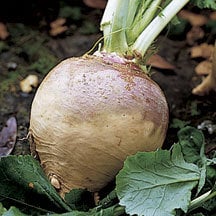
Learning Download: How to Grow Rutabaga
From Seed to Harvest: A guide to growing rutabaga.
Rutabaga are a cross between turnips and cabbage. They are in the mustard family and they have a golden root that tastes like peppery cabbage and sweetens as it is cooked.
To plant:
Plant rutabagas by direct sowing seeds in the late spring after all dangers of frost have passed. Plant the seeds about 1/2 inch deep.
To grow:
Once seedlings reach 3 to 4 inches tall, thin them to leave enough space for the bulbs to mature. The thinned seedlings can be added to a salad or stir fry and are safe to consume. Rutabagas require at least one inch of water a week to allow for adequate root development. They don’t grow well in hot, dry weather. If the plant becomes dried out, its bulb will crack and it won’t taste as sweet when harvested.
Although rutabagas aren’t as bothered by pests and diseases as other members of the Brassica family, you should still rotate the area in which you grow your Brassicas after each season. Several different bugs can chew on the leaves of the rutabaga, so if you plant on harvesting the greens, consider using a row cover to keep the harmful bugs away from the plant. Rutabagas can take up to 3 to 4 months to come to maturity, which is a long growing season.
To harvest:
In addition to its roots, rutabaga greens also can be harvested. The greens can be harvested anytime after they have reached 4 inches tall. As long as you don’t harm the top of the bulb, the greens will regrow. The bulb is ready to harvest when it measures 3 inches in diameter. Larger bulbs will be tougher to eat. If you leave them in the ground past a frost or two, the bulbs will taste sweeter.
What rutabaga craves:
There are a few tips when it comes to fertilizing rutabaga. The key is to add a light dressing of fertilizer to the area you plan to plant your rutabaga seeds a few weeks prior to planting. Then apply another serving of fertilizer to the seeds’ soil and water it in one month after planting. Add a side of compost in the middle of the growing season.
Where to buy rutabaga seeds:
You can find rutabaga seeds at Urban Farmer.
Learning Download: Common pests and diseases: Rutabaga
Common pests and diseases: Rutabaga
When growing vegetables, it is always exciting to care for the plant throughout its growing phase and then harvest it for delicious recipes later on, but one thing to watch out for is pests and diseases. Different plants are susceptible to different types of pests and diseases, and it is important to make yourself aware so you can keep a watchful eye and also take any preventative methods to keep your plants safe throughout their lifespan.
Rutabaga can fall victim to several different pests and diseases.
Pests:
Some of the pests affecting rutabaga include the cabbage aphid, the flea beetle and root maggots.
Cabbage aphids can stunt plant growth and even cause death. The insects are gray-green and will be visible on the leaves. These aphids only feed on cruciferous plants, but can survive on related weeds. If the infestation isn’t bad, prune out the affected leaves. However, if the infestation is heavy, spray the sturdier plants with a strong jet of water to knock the aphids off the leaves.
The flea beetle looks like a dark colored beetle which jumps. It will cause holes or pits in the leaves. It feeds especially on young plants or seedlings. To treat, utilize floating row covers or plant seeds early.
Root maggots will create tunnels on the rutabaga or they can also create scars on the fruit, and they can cause extensive root damage. To treat, practice crop rotation, destroy all crop debris and utilize floating row covers.
Diseases:
Some of the common diseases affecting rutabaga include Alternaria leaf spot, Anthacnose, black spot, downy mildew and more.
Alternaria leaf spot causes round or irregular lesions on older leaves. This disease prefers wet conditions, and it is a fungus. It can be controlled by practicing crop rotation, destroying all crop debris after harvest and applying the appropriate fungicides.
Anthracnose will cause circular or irregularly shaped dry spots on the leaves. The leaf may die if there are many spots. This disease prefers warm and moist conditions. To prevent it, treat seeds with hot water prior to planting and plant in soil with good drainage. You can also remove all weeds which may house the fungus.
Black rot will cause seedlings to develop yellow or brown leaves that wilt and collapse. It is most prevalent in warm, wet conditions. To control this disease, practice good sanitation, plant disease-free seed and rotate crops.
Downy mildew will cause irregular yellow patches which turn brown. These patches are located on the leaves. A gray growth will appear on the bottom of the leaves. The disease is more likely to occur when the environment is cool and wet. To prevent this, remove crop debris and practice good crop rotation.

